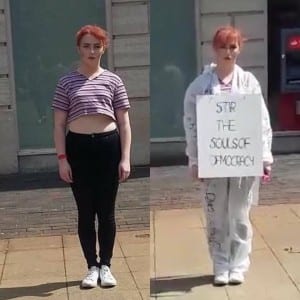
Framing Statement
If “…theories are only made to die in the war of time” (Shukaitis, 2013. P.251) then I believe the site specific performance I created will soon be irrelevant to both the site, time period and audience. This, I find is the beauty of Site Specific performance for the end product created may be considered pointless and meaningless if taken out of the correct context.
My performance, Deliberation, took place Thursday 5th May, at one pm in Speaker’s Corner, Lincoln, for twenty minuets. The audience consisted of members of the public ranging through all ages and through out my whole performance. I really wanted the audience to stop and watch through their own choice, seeing is freedom and deliberation were factors of my final piece. the majority of the audience remained silent, as I remained silent. Personally, I found this a great success that strangers were willing to silently watch me work and engage with the phrases on my placards and the words I was writing on myself.
Lincoln City holds a great history and as I researched this history and walked around the city I found myself asking, how can I remind my community of our past and encourage them to, make the changes that will influence our future. In 1908, the suffragettes held a rally at the Cornhill Exchange and in 2010 this site was name Speaker’s Corner, the cities official space for political activism, because of this I chose Speaker’s corner as my site.
I personally believe my final work was influenced my greatly by the Situationist International, this avant-garde group, who carry on from where the Dadaist and surrealist left off. What really resonated with me about their work is how they “speak of a unified vision of art and politics” (Knabb, 1981, p.16) and I hoped my work will do the same, however they also were clear that their work does it recommend “any sort of subordination of art politics” (Knabb, 1981 p.17).
La Ribot’s writing on the canvas hung from her neck and how she embodied herself within her performance also inspired me as I’ve spent this whole process fascinated by the idea of palimpsest and how my body can be a part of the performance without putting myself as a person in the performance.
Analysis of Process
A PLACE FOR OUR VOICE.
I started my research and devising process by spending time within my site and observing how others made use of it. I was initially hoping that I would be overwhelmed with a great sense of community, but found that my site is merely used it to cut through to another place or to quickly make use of the benches and ATMs. This had me question whether Speaker’s Corner was really a place or a non place. Personally, I felt my site felt more like a place of transition and I found this to be quiet disheartening, given in 1908 this site was the home to one of the suffragette’s rallies in Lincoln.

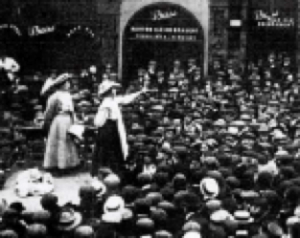
Marc Auge suggests: “If a place can be defined as relational, historical and concerned with identity then a space which cannot be defined as relational, or historical or identity will be non-place” (Augé, 1995), however I believe my site challenges Auge’s theory. Speaker’s Corner was given the identity as Lincoln’s official space for the community to voice their opinions, it’s our given space for freedom of speech and political activism. Yet this identity and the site’s history is being overshadowed by the modern presences. This lead me to question whether Lincoln had lost its care for a public voice or they we’re afraid to stand out and use their voice. This has confirmed with me that I want my final piece to remind the community they should be using their voices and honouring the fact we have a safe place where we can freely fight for change.
From research, I found Emily Wilding Davison’s Great Granddaughter, Dr Helen Pankhurst, believes the suffragettes would be fighting to; “Increasing the numbers of female voters”, “A more diverse Government”, “Ending Violence against women”, “the growth of the pornography industry worldwide”, “the rape culture that blames the victim” (Pankhurst, 2013). I wanted my final performance to highlight these issues and to encourage the public to use their voice and use this space. Unlike the Suffragettes, I’ve decided to take a less obvious and violent approach to my performance. I want my performance to be simple but cause the audience/public to leave questioning what they just saw, the issues it addresses, as my main aim for this performance is for the the audience to start talking about these issues and expressing their opinions freely.
Making Progress and Having a Script.
I’ve started practically exploring my ideas and one idea which I am keen to incorporate into my performance is Détournement. Détournement is “an artistic practice conceived by the Situationist International for transforming artworks by creatively disfiguring them” (Oxfordreference.com, 2016). The idea of creating a political statement through my actions and not my voice really resonates with me, as I am a firm believer actions speak louder than words.
A massive part of today’s rape culture is the campaign material published by the police force and government. This campaign material is supposed to ‘fight rape’ but in fact blames women instead, telling them how they could ‘stop’ themselves from being attacked.

Similar to Situationist International, I plan to ‘deface’ these posters as they openly victim blame. Victim blaming is a regular occurrence in the campaign posters created by the police forces and government. By doing this I hope my audience will also believe that instead of victim blaming and telling women what not to do, we should be targeting the predators. I also think it’s important to note how these posters target women, though men can be and are also victims of sexual assault.
Layering and Costume.
I decided my costume should be a part of my performance. I’ve decided wear white for this performance and shall deface this white outfit with words and phrases that are often linked to victim blaming. La Ribot’s project, Panoramix inspired this idea, as she says “To write is to let oneself be swept along by a tongue of black ink, that glides slowly without gesture or character…” (Live Art Development Agency, 2016). Though I intend not to characterises myself at all within this performance or use it as a form of political propaganda of my opinion, the words I write on myself are words that have already attracted my attention. Which disappointingly means to some extent there will be a part of myself and my own opinion within this performance, the only way I can conceal this is by the gesture in which I write on myself. Which I believe will work best if I perform the gesture of writing without any emotion, almost as if I was hypnotised by this gesture.
This idea of palimpsest (layering) should help me bring together the site’s history, the suffragette movement and the change I hope will be our future.
Being Specific to my Site.
I began to realise my performance should be less about what the suffragettes and more about having a voice and fighting for your opinion. The suffragettes fought for suffrage, using my site to air their voice. Today, Speaker’s corner, is our designated location of political activism, yet it became obvious to me the commercialisation of the space was more important than the political activism. I believe as a community we’ve allowed for our space of political activism to be over consumed by capitalism and commercialisation.
I’ve been very intrigued by the Situationist International and their artistic, political activist approach and from reading academic journal articles about their styles I found a quote which explains my view on Speaker’s Corner perfectly. “But theories are only made to die in the war of time” (Shukaitis, 2013. P.251). Relating this to Speaker’s Corner it become clear that the idea of having a place of political activism was just an ideal. Just like the suffragette movement, this history seems unimportant to our everyday uses of the site.
From this I developed my final performance. I decided my performance, Deliberation, should completely silent in which I write on myself, whilst wearing sandwich boards with political statements written across them. I found a sense of irony that I’m encouraging my audience to use their voice whilst not using my own. I want the audience to focus primarily on the written work as I believe written words have a bigger effect on the public than oral speech.
These placards will also bring together the the two histories of this site that I’m exploring whilst making them relevant to today. On one side I will have a statement which the suffragettes themselves used when protesting and on the other side I will have a statement taken from one of the speech’s given at the opening of Speaker’s corner. This use of placards has very much been inspired by the Gurrila Girls and how they used placards and posters to broadcast the change they’re fighting for. Which I’ve tried to get across in my placards too, which can be seen from the pictures below.


The Final and small changes.
I’ve decided to make some small changes to the aesthics of my piece. The first change I’ve made is too the content on my sandwich boards. I’m now using four short phrases; ‘Politicising Their Bodies’, ‘To Deal With Personality And Internal Contradictions’, ‘How Politics And History Work’ and ‘Stir The Souls Of Democracy’. Having, shorter and snappier phrases seemed more effective in rehearsals than longer ones. They gave the reader more to think about without giving too much away.
I’ve also returned to the idea of palimpsest by writing on myself. Wearing a white boiler suit, I intend to write words such as ‘Deliberation, Refugee, Expression, Cuts, NHS, Freedom, ect’ as these contrast my sandwich boards. I’ll be performing in a site which is riddled with political history on the day of our local elections. The town will be full of public members who will have hopefully just voted or about to go vote for their local councillors. The contrast of the sandwich boards and the current affairs which we should be addressing as a community, will encourage and hopefully inspire the audience to use their voices in a manner which fights for change and freedom.
Performance Evaluation
My final performance lasted roughly 15-20 minuets, as I personally felt if the performance lasted any longer it would have become tedious and the meaning would have been lost. I started stood outside Santander in my normal clothes, standing still staring blankly at my audience for a small period by time, I slowly changed into the boiler suit on top my clothes. I then picked the scissors and tape on the floor next to me and slowly taped out the original stage in which the suffragette rally was held, this being outside Santander. Returning to the centre, I put on my first sandwich board and again paused, allowing the audience to wonder what was about to happen next.
Then slowly I started to walk across the space whilst writing on the boiler suit, words such as “deliberation, freedom, NHS, refugee, cuts, voice, vote, expression, money”, words that relate to current affairs. I found this part a struggle because the sandwich board kept hitting me as I wrote preventing me from seeing what I was writing. On reflection, this could have seen to be an intentional metaphor for the sandwich board which represented our politics was obstructing myself from writing about the currents we need to change, meaning politics could metaphorically be obstructing our need for change. When I reached the Speaker’s Corner sign, I took off the first placard and started out the whole process again, making the journey back to my starting position. I found repeating this process between both stages, allowed me to connect both histories with today and hopefully the audience questioned why those two places were so important and perhaps researched for themselves.
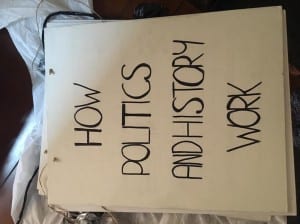
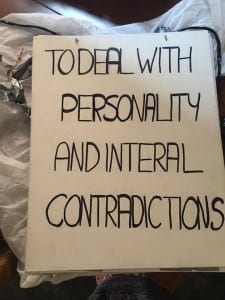
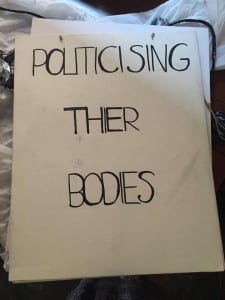


I started with an audience of three and by the end of my performance a bigger group of public members had collated to watch. Though there was no intentional audience involvement on my behalf, I found the audience followed me on the journey I made and afterwards were reading the sandwich boards and discussing what I had chosen to write on them. I found this alone to be a success as I hoped that the outcome of my performance would be for people to discuss politics more and freely voice opinions which happened.
The greatest success, was the college student who spoke to me and discussed my performance with me afterwards, asking me not only to explain but then telling me how now he knows the context that it was a great performance.
The final performance made me realise that actually the site and those who fill the site hadn’t lost their purpose or voice but perhaps just required a leader to lead them when using their voices as they needed that security and the confidence to do. For example, as they realised I wasn’t speaking they stayed silent too. The silence created, I found emphasized the performance and the words that had been written.
The final performance could have been improved by taking advantage of the silence and lengthening my pauses. I personally feel that by lengthening the silence I could gathered a bigger audience and triggered more questioning. On reflection, I feel I should have rehearsed with sandwich boards more, so writing on myself whilst wearing them wouldn’t have been so hard. In retrospect, the short amount of time I had to change my final performance was a major factor in the little rehearsal I eventually had.
I now I believe the site gave me a little but too much history to work with and at times I found myself weighed down with too much research and not enough practical work. I found that my methodology, through prioritising research over practical development actually slowed down my devising process.
I feel I know understand site specific theory and practice more than at the start of the module. At the start of the module, I thought Site Specific would have been easier than what it was, I also thought it was about the history of the site and not actually the site itself. However, it took the whole process for me to learn that the history had to still be relevant to the site for a piece to work. For example, though the suffragette rally at Speaker’s Corner was immense, it didn’t make sense to try to recreate anything similar today as currently everyone, who is a legal citizen in the UK, has the right vote. Therefore, making this history not irrelevant to the city but not relevant enough to create a piece of site specific drama.
Word count: 2700
Bibliography:
Augé, M. (1995). Non-places. London: Verso. PP 77-78.
Bailey, N. (2016) Defaced Boiler Suit.
Bailey, N. (2016) Placards.
Bailey, N. (2016) Mock Designs.
Bailey, N. (2016) Speaker’s Corner today.
Clarkson, C. (2016) Deliberation.
Google.co.uk. (2016). Redirect Notice. [online] Available at: https://www.google.co.uk/url?sa=i&rct=j&q=&esrc=s&source=images&cd=&ved=0ahUKEwjxl_TBqNfMAhUhIMAKHUJ1AHoQjRwIBw&url=http%3A%2F%2Fwww.huffingtonpost.co.uk%2F2014%2F07%2F31%2Fnhs-dimisses-outrage-over-rape-posters-victims_n_5636953.html&psig=AFQjCNE6DKYfDG_mKCO8dykWKgagOZ4VqQ&ust=1463238012233902 [Accessed 13 May 2016].
Guerrilla Girls. (2016). PROJECTS. [online] Available at: http://www.guerrillagirls.com/projects/ [Accessed 13 May 2016].
Live Art Development Agency. (2016). La Ribot – Projects – Live Art Development Agency. [online] Available at: http://www.thisisliveart.co.uk/projects/la-ribot/ [Accessed 9 May 2016].
Oxfordreference.com. (2016). Situationist International – Oxford Reference. [online] Available at: http://www.oxfordreference.com/view/10.1093/acref/9780199239665.001.0001/acref-9780199239665-e-2519 [Accessed 10 May 2016].
Pankhurst, D. (2013). Feminism: what would the suffragettes be fighting for today?. [online] Telegraph.co.uk. Available at: http://www.telegraph.co.uk/women/womens-politics/9825131/Feminism-what-would-the-suffragettes-be-fighting-for-today.html [Accessed 3 Mar. 2016].
Speakerscornertrust.org. (2016). Lincoln | Speakers Corner Trust. [online] Available at: http://www.speakerscornertrust.org/speakers-corner-projects/uk-projects/lincoln [Accessed 13 May 2016].
YouTube. (2016). “Deliberation”. [online] Available at: https://www.youtube.com/watch?v=-MDVtxp-14k [Accessed 13 May 2016].